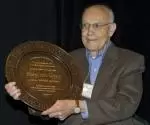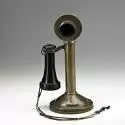Remembering Stephen

He was the ultimate collector.
Passionate, determined, informed, opinionated.
And everyone who knew Stephen Gray has a story to tell.
My first was set in New York City, at one of David Rago’s early auctions held for a few years in the Puck Building near the SoHo district of lower Manhattan. It was 1988 and I was there promoting one of the early Arts and Crafts Conferences at the Grove Park Inn. Manhattan was the center of the Arts and Crafts universe back then. The major dealers each had a gallery there: Jordon-Volpe, Michael Carey, Don Magner, Beth Cathers, Peter-Roberts, Gallery 539. Arts and Crafts was new, it was hot, and it was the favorite of the artsy, celebrity crowd: Robert Mapplethorpe, Jackson Brown, George Lucas, Kipp Forbes, and, of course, Barbra Streisand, who was there that day, dressed in faded jeans and a sweatshirt, adding a few more pieces to her collection.
I had just been introduced to Stephen Gray, whose name I recognized immediately as the publisher of Turn of the Century Editions, those small, authentic reproduction sales catalogs that unlocked for tens of thousands of collectors the doors to a treasure trove of Stickley, Limbert and Roycroft furniture scattered across the country.
The perimeter of the room was lined with fabulous pieces, many fresh from summer cabins in the Adirondacks, bungalows in the suburbs, and rent-controlled apartments in the city. Back then the Arts and Crafts universe revolved around two auction houses, Christies and Sotheby’s, whose spring and fall 20th Century Decorative Arts auctions were to the Arts and Crafts crowd what New York Fashion Week was to the world of designer clothing.
Tucked amid an early Gustav Stickley chest of drawers and Dard Hunter-Karl Kipp leaded glass table lamp was a small, upright hammered copper telephone stamped with the Roycroft orb-and-cross mark. It appeared to have been lost and overlooked, but Stephen had his eye on it, knowing it would be the perfect accessory on one of his early Stickley desks. As the telephone was carried to the auctioneer’s podium, Stephen stepped up beside me, slipped me his bidding card, and whispered, “Here, bid on it for me. If they see me bidding, they’ll run it up on me.”
“They,” I later learned, were a dozen or so dealers in the crowd who had battled Stephen at earlier auctions, or whose clients had sought Stephen’s advise on a particular piece they were considering. And Stephen was never shy about voicing his opinion, whether it had to do with rarity, condition or restoration.
I don’t know who was more nervous: me, fresh from the fields of Iowa, or Stephen, pacing off to my left as the bidding started. With each slight nod of his head, my hand shot into the air, pushing the bidding toward the one thousand dollar mark. In the world of Grueby-tiled tables, massive Marblehead vases, and inlaid Harvey Ellis chairs, this little copper telephone was small potatoes, hardly worth a glance up from the auction catalog, but to Stephen it could just as easily have been the Holy Grail of the Arts and Crafts movement.
I had no idea how high he was willing to go on the upright telephone, and had visions of my budding career as an Arts and Crafts writer and conference director going up in smoke if I somehow managed to miss his nod, misinterpret his meaning or, heaven forbid, drop the cardboard number clenched in my sweaty palm and lose it on the floor amid the tangle of feet and legs around me.
The bidding paused as the auctioneer was asking for fifteen hundred dollars, a seemingly ridiculous sum for an old telephone, when Stephen, as nervous as a stallion in the gates of the Kentucky Derby, simply couldn’t stand it any more. He reached over, snatched his card back and took over the bidding, regardless of the consequences.
Relieved, I stumbled backward, out of the way as Stephen brazenly began bidding on the Roycroft telephone, which, naturally, he eventually won. Later, he caught my eye in the crowd, and gave me a nod and a slight smile.
After a long battle with cancer, Stephen passed away this past Saturday. For more than twenty years he had come to the Grove Park Inn Conference each February, occasionally to add a special piece to his collection, but more often just to spend time with his friends, with those who shared his passion for anything and everything Arts and Crafts.
And on that same Saturday, I sat in my office here in North Carolina, staring at this same computer, watching yet another David Rago Arts and Crafts auction, when on my screen came a familiar image: Lot 47 – A Rare Roycroft Upright Telephone.
It sold for more than ten thousand dollars.
Stephen always knew.
Many thanks, my friend, for handing us the keys.

Until next Monday,
Have a great week!
Bruce
